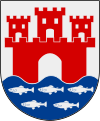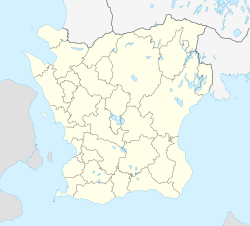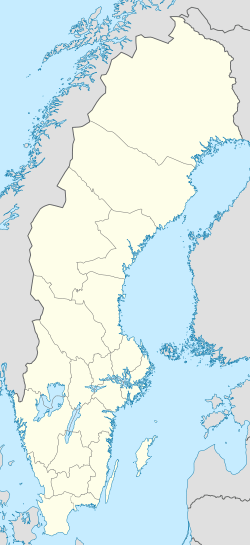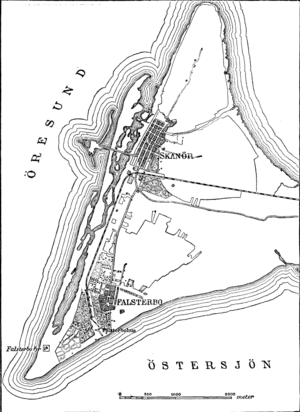Skanör med Falsterbo facts for kids
Quick facts for kids
Skanör med Falsterbo
|
||
|---|---|---|
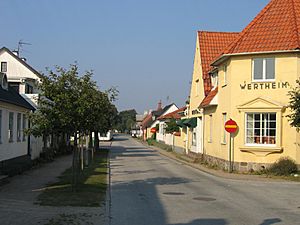
Old part of Falsterbo
|
||
|
||
| Country | Sweden | |
| Province | Scania | |
| County | Skåne County | |
| Municipality | Vellinge Municipality | |
| Area | ||
| • Total | 5.42 km2 (2.09 sq mi) | |
| Population
(31 December 2010)
|
||
| • Total | 6,937 | |
| • Density | 1,280/km2 (3,300/sq mi) | |
| Time zone | UTC+1 (CET) | |
| • Summer (DST) | UTC+2 (CEST) | |
Skanör med Falsterbo is a town in Sweden. It's located in Skåne County, which is in the south of the country. About 7,000 people lived here in 2010. This town is actually two older towns, Skanör and Falsterbo, that grew together in 1754. Even today, many locals still think of them as separate places. The word "med" means "with" in Swedish. Because it's so far south and close to the sea, Skanör med Falsterbo has the mildest weather in Sweden. Winters here are not very cold, and it rarely freezes.
Contents
What is Skanör med Falsterbo?
Skanör med Falsterbo is made up of two old towns from the Middle Ages: Skanör and Falsterbo. Both towns are found on the western part of the Falsterbo Peninsula. Falsterbo is to the south, and Skanör is to the north.
These towns are separated by a long bank made of earth and seaweed. They have never been seen as the same town geographically. The peninsula is the very southwestern tip of the Scandinavian Peninsula. It marks the boundary between the Baltic Sea and the Øresund. The Øresund is a narrow body of water that separates the Danish island of Zealand from the southern Swedish area of Scania.
Where is Skanör med Falsterbo located?
This area is south of the city of Malmö. Skanör is about 28 kilometers away, and Falsterbo is about 30 kilometers away. Over the last century, these towns have become popular places to live. Many people who work in the Malmö-Lund area choose to live here. It's also a favorite spot for older people who have retired.
The peninsula is divided by the Falsterbo Canal. This canal is a waterway that makes the journey between the Øresund and the Baltic Sea shorter. It was built during World War II to help ships avoid mines that were placed in the Øresund. The canal connects two bays: Höllviken in the north and Kämpingebukten in the south.
What is the climate like?
The Swedish weather institute, SMHI, has a weather station in Falsterbo. Like the rest of Scania, it has an oceanic climate. This means it has mild winters and cool summers. However, because it's right on the peninsula, the sea has a bigger effect on its weather.
Falsterbo is the southernmost official weather station in Sweden. This means it has very mild winters. The average temperature in January from 1961 to 1990 was above freezing, which is very unusual for Sweden. Falsterbo is often cooler than Malmö during the day but milder at night. This is because the temperature doesn't change much between day and night.
The sea's strong influence means that extreme hot or cold temperatures are rare here. However, temperatures have dropped to -24°C and risen to 30°C in the past. In 2006, the lowest temperature in December was 3°C, which is very mild for Sweden. The average rainfall from 1961 to 1990 was 490.6 millimeters. This makes it a very dry place for an oceanic climate.
Falsterbo is the mildest weather station in Sweden because of its strong connection to the sea. It also gets more sunshine than inland places like Lund. Falsterbo gets about 1902 hours of sunshine each year, compared to Lund's 1801 hours. This is because there are fewer clouds forming in spring and summer.
| Climate data for Falsterbo (2002–2022 averages & extremes since 1901) | |||||||||||||
|---|---|---|---|---|---|---|---|---|---|---|---|---|---|
| Month | Jan | Feb | Mar | Apr | May | Jun | Jul | Aug | Sep | Oct | Nov | Dec | Year |
| Record high °C (°F) | 10.3 (50.5) |
9.6 (49.3) |
13.7 (56.7) |
20.7 (69.3) |
24.7 (76.5) |
28.2 (82.8) |
30.0 (86.0) |
29.0 (84.2) |
24.4 (75.9) |
19.1 (66.4) |
15.7 (60.3) |
11.2 (52.2) |
30.0 (86.0) |
| Mean maximum °C (°F) | 7.2 (45.0) |
6.4 (43.5) |
10.1 (50.2) |
15.5 (59.9) |
21.3 (70.3) |
24.2 (75.6) |
26.3 (79.3) |
25.8 (78.4) |
21.5 (70.7) |
16.8 (62.2) |
12.1 (53.8) |
8.4 (47.1) |
27.2 (81.0) |
| Mean daily maximum °C (°F) | 3.3 (37.9) |
3.1 (37.6) |
5.6 (42.1) |
10.2 (50.4) |
15.2 (59.4) |
19.3 (66.7) |
21.5 (70.7) |
21.3 (70.3) |
17.8 (64.0) |
12.5 (54.5) |
8.4 (47.1) |
5.1 (41.2) |
11.9 (53.5) |
| Daily mean °C (°F) | 1.9 (35.4) |
1.6 (34.9) |
3.5 (38.3) |
7.4 (45.3) |
12.1 (53.8) |
16.2 (61.2) |
18.5 (65.3) |
18.5 (65.3) |
15.3 (59.5) |
10.7 (51.3) |
7.0 (44.6) |
3.7 (38.7) |
9.7 (49.5) |
| Mean daily minimum °C (°F) | 0.4 (32.7) |
0.1 (32.2) |
1.4 (34.5) |
4.5 (40.1) |
9.0 (48.2) |
13.1 (55.6) |
15.4 (59.7) |
15.7 (60.3) |
12.8 (55.0) |
8.8 (47.8) |
5.5 (41.9) |
2.3 (36.1) |
7.4 (45.3) |
| Mean minimum °C (°F) | −6.6 (20.1) |
−5.7 (21.7) |
−3.6 (25.5) |
−0.1 (31.8) |
4.1 (39.4) |
9.4 (48.9) |
12.4 (54.3) |
11.5 (52.7) |
7.6 (45.7) |
2.1 (35.8) |
−1.2 (29.8) |
−3.3 (26.1) |
−8.5 (16.7) |
| Record low °C (°F) | −24.5 (−12.1) |
−19.2 (−2.6) |
−18.0 (−0.4) |
−9.0 (15.8) |
−2.7 (27.1) |
3.0 (37.4) |
6.6 (43.9) |
7.5 (45.5) |
2.0 (35.6) |
−3.8 (25.2) |
−8.3 (17.1) |
−12.9 (8.8) |
−24.5 (−12.1) |
| Average precipitation mm (inches) | 37.5 (1.48) |
27.0 (1.06) |
28.0 (1.10) |
24.3 (0.96) |
36.0 (1.42) |
48.4 (1.91) |
58.3 (2.30) |
84.0 (3.31) |
41.9 (1.65) |
54.1 (2.13) |
45.9 (1.81) |
43.7 (1.72) |
529.1 (20.85) |
| Mean monthly sunshine hours | 45 | 68 | 141 | 231 | 275 | 278 | 272 | 240 | 185 | 115 | 52 | 31 | 1,933 |
| Source 1: SMHI | |||||||||||||
| Source 2: SMHI Monthly Data 2002–2021 | |||||||||||||
History of Skanör and Falsterbo
How the Towns Began
The town of Skanör started around the late 1100s. Falsterbo is thought to have begun a little before that. Around 1220, the Danish king built a fortress in Skanör. The S:ta Gertrud church in Falsterbo dates back to the 1200s, or possibly even the 1100s.
Growth and the Scania Market
During the Late Middle Ages, both towns became very important and wealthy. This was because of the annual Scania Market (Skånemarknaden). This market was a major center for trade and herring fishing. It took place on the beach between Skanör and Falsterbo during late summer and autumn.
The market was mostly controlled by German trading cities, especially Lübeck. The Danish king gave these cities special areas along the beach where they could trade. A large fishing village was also located along the beaches of Øresund.
Soon after, a castle was built in Falsterbo. In 1311, this castle was destroyed by the Hanseatic League. This happened during a war between the League and the Danish king Erik Menved. After the war, the king built a new, larger castle called Falsterbohus in 1318. The old castle in Skanör became less important after this. Olav IV of Norway, the son of Queen Margaret I of Denmark, passed away in Falsterbohus in 1387.
After the number of herring fish decreased in the 1500s, the Scania Market ended. Because of this, the two cities lost their importance. However, they kept their town rights and continued to be managed together.
Recent History and Changes
The two medieval towns, Skanör and Falsterbo, were officially joined under the same mayor in 1754. Even so, they were not seen as one town geographically. They only grew into one continuous settlement in the late 1960s.
Skanör and Falsterbo remained small fishing towns for a long time. This changed when a railway line from Malmö to Falsterbo was built in 1904. From 1904 to 1971, Skanör and Falsterbo each had their own train stations. New homes and neighborhoods grew up along the railway.
Skanör med Falsterbo was the last city in Sweden to get its own City Council in 1934. It also had its own local court until 1947. Today, it is part of Vellinge Municipality and does not have its own separate administration. The railway closed in 1971 and was taken apart the next year.
Skanör Cement Factory
During World War I, a train track was built to a new cement factory in the Skanör harbor. Some people say the factory was used to store military equipment in case the war reached Sweden. Others believe the factory was built by German influence as a cover for a huge artillery base. They claim the bricks were placed upright to save money. This cannon, along with another in Køge in Denmark, was meant to guard the Øresund. The cement factory was taken down a few years later. Only its foundation remains today.
What makes Skanör med Falsterbo special?
Falsterbo is well-known for the Falsterbo Bird Observatory. This is because most migratory birds leave the Scandinavian Peninsula by flying over a 5-kilometer-long reef south of Falsterbo. This same reef and the beautiful sandy beaches on the peninsula offer some of the best sea swimming in Sweden.
Falsterbo also hosts an annual horse show, the Falsterbo Horse Show. This event features both show jumping and dressage. Skanör used to hold its own yearly market, called Skanörs sillamarknad.
Images for kids


